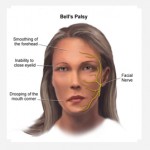Facial Palsy Physiotherapy Treatment
Facial Palsy is a form of facial paralysis resulting from a dysfunction of the cranial nerve VII (the facial nerve) that result in the inability to control facial muscles on the affected side.
Facial Palsy Causes
|
Varcella-zoster infection |
Myasthenia gravis |
|
Epstein-Barr virus |
Multiple sclerosis |
|
Middle ear infection |
Guillain –Barre syndrome |
|
HIV infection |
Tumour causing nerve compression |
|
Lyme disease |
Pregnancy |
|
Sarcoidosis |
Stress |
|
Trauma to facial nerve |
Viral infections such as herpes, mumps, influenza, a cold, infectious mononucleosis |
|
Metabolic and emotional disorders |
|
|
Environmental factors( cold climates) |
Facial Palsy Symptoms
- Symptoms most often start suddenly, but may take 2 – 3 days to show up. They do not become more severe after that.
- Symptoms are almost always on one side only. They may range from mild to severe.
- Sometimes person may have a cold shortly before the symptoms of Bell’s palsy begin.
- The face will feel stiff or pulled to normal side, and may look different.
- Difficulty eating and drinking; food falls out of one side of the mouth
- Unable to close one eye.
- Sound that is louder in one ear (hyperacusis).
- Twitching or weakness of the muscles in the face.
- Drooling due to lack of control over the muscles of the face.
- Drooping of the face, such as the eyelid or corner of the mouth.
- Problems smiling, grimacing, or making facial expressions.
- Dry eye or mouth, headache, twitching of facial muscles.
Facial Palsy Physiotherapy Measures
- Modalities for stimulation of denervated muscles in order to reeducate the functions
- Soft tissue techniques are implimented to recovery to help prevent permanent contractures of the paralyzed facial muscles.
- Taping technique.
- To maintain muscle tone of the affected facial muscles by doing facial exercises in front of mirror




